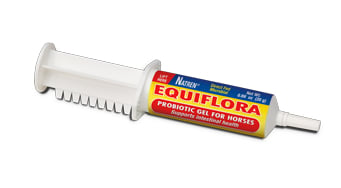
When you look at probiotic supplementation for horses OR humans, the two most important factors are:
1. How powerful is that species and strain of bacteria within the gut of the host, in terms of what it can accomplish (anti-viral, antibiotic, anti-yeast, etc.)?
2. How well can the probiotic survive and colonize (stick to the gut wall) the digestive system of the host?
So you need to look for an equine probiotic that has an effective delivery system – one that will keep the bacteria live and viable from the container, through the acids of the stomach.
Any manufacturer can list a bacterial count (cfu – colony forming units) on the bottle, but if they do not guarantee this amount as live, viable bacteria through to the expiry date, then you are throwing your money away. Who cares if the manufacturer put 10 billion cfu per serving into the syringe, when 9 billion are dead by the time you administer the probiotic to your horse?
The probiotic that I use with my horse is Natren’s Equiflora. Equiflora is a Direct Fed Microbial containing live (viable) naturally occurring microorganisms.

Natren Equiflora contains Lactobacillus acidophilus NAS, which is a friendly intestinal flora that promotes intestinal health, assists in the digestion of proteins, has anti-fungal activity, and plays a role in preventing candida overgrowth, yeast infections, urinary tract infections and in cancer prevention. Lactobacillus acidophilus may also benefit cholesterol levels, nutrient assimilation, detoxification, post-antibiotic treatment, constipation and diarrhea control, bad breath, gas, and intestinal disorders.
The gel carrier that enrobes the probiotics was developed by a German veterinarian and consists of vegetable oil, Vitamin E, Vitamin A and selenium – no preservatives and nothing artificial! The gel (not the probiotics – those need to be refrigerated) is designed to be stable in temperatures up to 140 degrees Fahrenheit to protect the probiotic bacteria from the environment and from gastric juices.
The gel probiotic also contains a special microorganism called Enterococcus faecium NCIMB 10415. E. faecium is monitored by a German government agency for safety, and is exclusively available in the Natren line of animal probiotics.
So whichever probiotic you choose to give your horse, just make sure the beneficial bacteria are guaranteed LIVE through to the expiration date and that the probiotic can be delivered in a way that ensures those bacteria will reach the horse’s intestines (survive the gastric juices) live and ready to go to work!
Oh, and one last benefit to Equiflora, some horses love the probiotic gel and will even lick it off your fingers! My daughter’s mare, who is super picky will not lick it off my hand, and if I come near her with the syringe, she thinks it’s a wormer. So I just break up a carrot, squirt the dosage on 2 or 3 pieces of carrot and she consumes that willingly. For my horse, I squirt it onto her minerals and seaweed, then sprinkle a bit of her pelleted minerals on top and she gobbles it up.

Jini Patel Thompson is a natural health writer and Lazer Tapping instructor. She began riding at age 2 in Kenya, and got her first horse at age 8 in Alberta, and so continues a life-long journey and love affair with these amazing creatures.








Great to know about this Jini. I am in need of probiotic for one of my horses. So it looks like there are several doses in one syringe. How often do you give it to your horses? Do you just have some handy in the fridge just in case? Thanks!
You know, I just feel into each horse – whether they want it and how much they need. Sometimes they ask for a double dose, then for the next few days a single dose, then nothing. They also get some probiotics in their High Point feed though. The only time I’ve been regular about dosing with Equiflora is when they first arrived (to establish a good gut flora), after Montaro received antibiotics, and then in the Spring when the worms are activating. And yes, I do keep some in the fridge in my garage! I believe there are 10 doses per syringe. You can see it works though as if I give a double dose, the horse’s stool will get loose – probably from die-off.